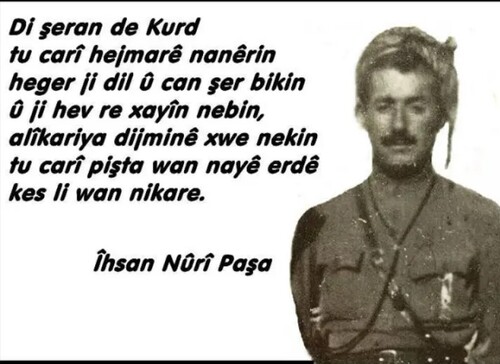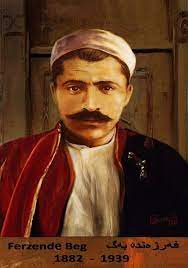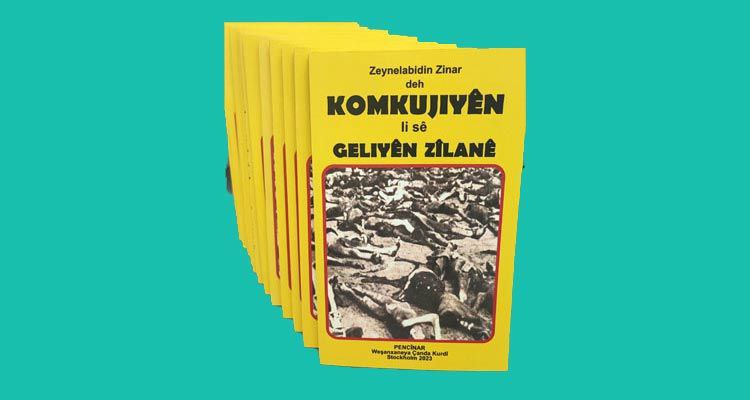Read the second part of this article here
Agri Revolution; The Time of Genocide
In 1929, the Kurdish national revolution began to get stronger in Agri Mountain under the leadership of General Ihsan Nouri Pasha (1892 _ 1979). General Ihsan Nouri Pasha was born in 1892 in Badlis. He began his education in a Kurdish school and then attended the Military school of the Ottomans and finished his education in the Ottoman Military Academy in 1910.

Figure: Ihsan Nouri Pasha
Kurdish fighters from all parts of the country began the revolution and gathered around the late leader of the revolution, Ihsan Nouri Pasha. Later, he needed many riders to protect the borders of the mountain and to deliver urgent news and reports. However, there were not many horses available for the revolutionary forces. Sardar Ihsan Nouri Pasha sent "Farzanda Bag Hassani" with 60 horsemen to provide more horses from the tribes (1939 _ ?). Each of the regional tribes gave them some horses.

Figure: Farzanda Bag
After that, the sound of horses' neigh and their hoofbeat reached Ankara. the Turkish military commander in the east sent two cavalry officers to fight Farzanda Bag. Both of the groups of the cavalries were sent to the plain where the horses had been collected. A group was at Zilan Valley and while confronting Farzanda Bag, they could not find a way to fight him because the Turkish soldiers knew Farzanda was a hero warrior. Thus, the soldiers chased him from a far distance until the other group caught up with them. Farzanda had heard the news and did not want to fight both groups. He gave the horses he had collected to ten cavalries to take them to Agri Mountain and he attacked the Turkish military group with 50 men.
His attack began quickly. His fighters followed him, surrounded the Turkish military group, and shot down many Turkish soldiers from their horses. Soon the Turkish soldiers ran away, most of them were captured and many of their corpses were left on the ground. The Turkish soldiers had never seen such a fata battle so they could not protect themselves from the Kurdish warriors. Farzanda and his men seized many of the Turkish soldiers' horses and sent them to Agri Mountain. The Turkish soldiers' horses, however, were not as fast as the Kurdish horses.
Within an hour of fighting, the field was filled with dead soldiers' bodies and many of their horses and rifles fell into the hands of Kurdish fighters. When the other group reached the fronts of the battle, they did not see anyone except Farzanda and his men. In a split of time, Farzanda reached them and threw most of them on the ground. The Turkish soldiers could not use their guns in this battle. The horses and rifles of those who were killed or fled were left for the Kurdish soldiers. According to some sources, the number of Turkish soldiers killed on that day was 250 people but only three Kurdish fighters were wounded. Surely, the 50 Kurdish fighters who killed 250 Turkish soldiers and defeated two groups of Turkish military forces recorded a great victory.

After the battle ended, Farzanda collected the horses and rifles of the dead soldiers and went to Agri Mountain. Four or five days after the battle, the Turkish generals of the two military groups were unable to gather their escaped soldiers. After this great loss they had suffered, it was difficult for them to say that Farzanda had defeated them badly with only fifty men. The commanders of both groups sent their defeat report to the President and said: "All the tribes of Zilan Valley helped out Farzanda thus most of our soldiers were killed."
Now, the Turkish government decided to hold a direct meeting with Ihsan Nouri Pasha. It remained without results. Based on this report, the Turkish government ordered to destruction of 200 villages in Zilan Valley. This was the first reason for the Kemalist government of Turkey to carry out 10 genocides in Zilan Valley.
On May 9, 1928, Turkey issued a pardon for the mountain freedom fighters. However, Suleiman Nazif in a speech said: "Anyone with a gun must be executed." At the meeting of the Council of Ministers chaired by Mustafa Kemal (Ataturk), the chief of staff of the Chakmak army and the first inspector-general Ibrahim Tali (Ongorn) were present and they issued the resolution of the 29th law of January 2, 1929 no. 8692. They launched a military movement in June for the Agri Revolution. On January 7, 1930, the Council of Ministers decided to clear the villages in the area between Kop and Shihly where the Kurdish fighters were staying, and destroy all those areas that had helped the revolution.

Regarding the collapse of the Kurdish National Revolution, Ihsan Nouri Pasha said:
We, the Kurdish forces, did not have a basic structure.
The number of Turkish soldiers increased greatly.
The Turkish army had discipline.
The Turks sought help from Iran and the Soviet Union.
They blocked our paths and we did not receive any cooperation from the other regions.








